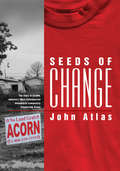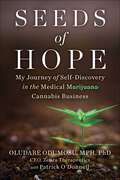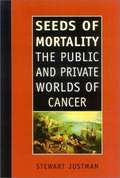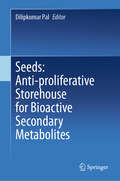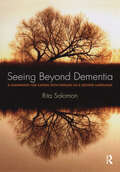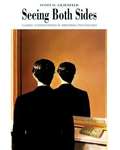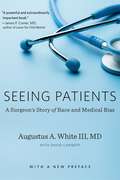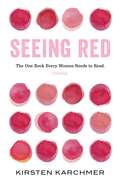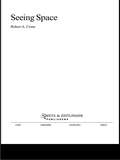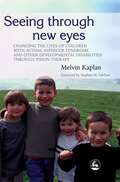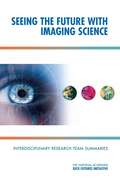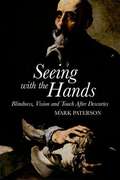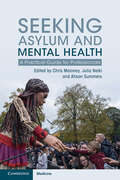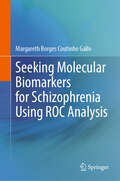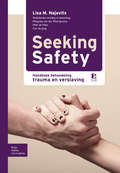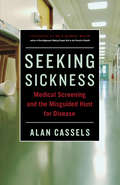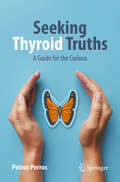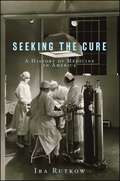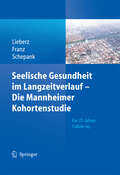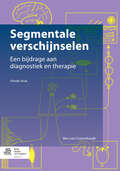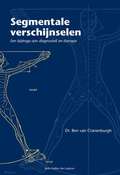- Table View
- List View
Seed-borne plant virus diseases
by K. Subramanya SastrySeeds provide an efficient means in disseminating plant virus and viroid diseases. The success of modern agriculture depends on pathogen free seed with high yielding character and in turn disease management. There is a serious scientific concern about the transmission of plant viruses sexually through seed and asexually through plant propagules. The present book provides the latest information along with the total list of seed transmitted virus and viroid diseases at global level including, the yield losses, diagnostic techniques, mechanism of seed transmission, epidemiology and virus disease management aspects. Additional information is also provided on the transmission of plant virus and virus-like diseases through vegetative propagules. It is also well known that seed transmitted viruses are introduced into new countries and continents during large-scale traffic movements through infected germplasm and plant propogules. The latest diagnostic molecular techniques in different virus-host combinations along with disease management measures have been included. The book shall be a good reference source and also a text book to the research scientists, teachers, students of plant pathology, agriculture, horticulture, life sciences, green house managers, professional entrepreneurs, persons involved in quarantines and seed companies. This book has several important features of seed transmitted virus diseases and is a good informative source and thus deserves a place in almost all university libraries, seed companies and research organizations.
Seeding Consciousness: Plant Medicine, Ancestral Wisdom, and Psychedelic Initiation
by Tricia Eastman• Provides a blueprint for responsible and effective use of psychedelics and plant medicines to transform pain and trauma into profound connections with ourselves, nature, and the spirit world• Shares exercises to help readers plant the seeds of transformation in their own consciousness, navigate altered states of consciousness and ego death, work with the shadow, and integrate fragmented parts of the self• Explores ancestral teachings on the interconnectedness of all life, drawing on the author&’s studies with indigenous elders, including Bwiti initiations with ibogaPresenting a deep dive into the world of psychedelic initiation and ancestral wisdom, Tricia Eastman demonstrates the power of plant medicine and psychedelic journeys for cultivating new beliefs, healing trauma, and accessing latent gifts within us—an inner alchemical process she calls &“seeding consciousness.&”Drawing on her studies with Indigenous elders, including two decades of iboga initiations with the Bwiti of Gabon, Africa, and training with the Kogi Kággaba of Columbia, Eastman provides a blueprint for responsible and effective use of entheogens to transform pain and trauma into profound connections with ourselves, nature, and the spirit world. She explores ancient teachings on the interconnectedness of all life and the forces of nature and shows how colonization and modern culture have disconnected us from our spiritual foundations. She shares exercises to help readers seed their own consciousness, navigate altered states of consciousness and ego death, work with the shadow, and integrate fragmented parts of the self. She also examines how to respectfully engage with these potent transformative plants, substances, and ancient traditions, thereby honoring the wisdom keepers who have safeguarded these traditions across the millennia.Revealing how to prepare the fertile soil of the mind for mystical experience, this book presents a psychedelic path to awakening that simultaneously facilitates personal transformation and collective societal change.
Seeds of Change: The Story of ACORN, America's Most Controversial Antipoverty Community Organizing Group
by John Atlas"There is more value on a single page of Seeds of Change than in a year's worth of Rush Limbaugh screeds combined with a lifetime of Sarah Palin sneers at community organizers." --Todd GitlinSeeds of Change goes beyond the headlines of the last Presidential campaign to describe what really happened in ACORN's massive voter registration drives, why it triggered an unrelenting attack by Fox News and the Republican Party, and how it confronted its internal divisions and scandals. Based on Atlas's own eyewitness original reporting, as the only journalist to have access to ACORN's staff and board meetings, this book documents the critical transition from founder Wade Rathke, a white New Orleans radical to Bertha Lewis, a Brooklyn African American activist. The story begins in the 1970s, when a small group of young men and women, led by a charismatic college dropout, began a quest to help the powerless help themselves. In a tale full of unusual characters and dramatic conflicts, the book follows the ups and downs of ACORN's organizers and members as they confront big corporations and unresponsive government officials in Albuquerque, Brooklyn, Chicago, Detroit, Little Rock, New Orleans, Philadelphia, and the Twin Cities. The author follows the course of local and national campaigns to organize unions, fight the subprime mortgage crisis, promote living wages for working people, struggle for affordable housing and against gentrification, and help Hurricane Katrina's survivors return to New Orleans. The book dispels the conservative myth that we can only help the poor through private soup kitchens and charity and the liberal myth that the solution rests simply with more government services. Seeds of Change, not only provides a gripping look at ACORN's four decades of effective organizing, but also offers a hopeful analysis of the potential for a revival of real American democracy. An offering of The Progressive Book Club.
Seeds of Hope: My Journey of Self-Discovery in the Medical Cannabis Business
by Patrick O'Donnell Dr. Oludare OdumosuAn immigrant's story of leadership, innovation, and humanity in cannabis medicine.Seeds of Hope is an eye-opening memoir of self-discovery and entrepreneurship set against a backdrop of the war on drugs. It&’s also a story of the transformative power of medical cannabis and its potential to revolutionize the healthcare industry. Written by Dr. Oludare Odumosu, MPH, PhD, it takes readers on a personal journey as he progresses from &“just say no&” to become one of the leading voices in the global cannabinoid space. Dr. Odumosu explores the history of cannabis and the devastating effects of the War on Drugs on cannabis medicine, addiction, and the minority community. He shares his personal experience in cannabis medicine and entrepreneurship, including fears, frustrations, and triumphs, as he and his team run an ever-changing gauntlet of state and federal rules and regulations.Seeds of Hope is a must-read for anyone interested in the transformative power of medical cannabis, including aspiring entrepreneurs. It&’s also an inspiring memoir that offers hope, insights, and lessons learned on leadership, success, and achieving one&’s dreams.
Seeds of Mortality: The Public and Private Worlds of Cancer
by Stewart JustmanUnless the patient's mind is made healthy, "whether the tumor shrinks or even goes into complete remission, genuine healing will not have occurred."
Seeds: Anti-proliferative Storehouse for Bioactive Secondary Metabolites
by Dilipkumar PalThis book presents extensive and up-to-date information on the anti-proliferative properties of various plant seeds for their application in pharmaceutical industry and medicinal research. This information is imperative for understanding and developing high quality products from the seeds.The book provides insights about anticancer and antitumour activities present in seeds. Different chapters cover the traditional knowledge as well as recent innovations in various seeds, such as prune, pumpkin, grape fruit, sesame, sunflower, bitter gourd, papaya, mango, apple, black plum, cumin, water melon, musk melon, cotton, carambola, pear, cardamon, moringa, wallich, Chinese cabbage, pistachio, etc. and their bioactivities for the applications in cancer and malignancy proliferation. The book introduces the readers to seed as a bioactive compound, and delineates the various health effects. It further explains the relation between the different metabolites and their effect on cell proliferation. Finally the book goes on to explain different seeds and their specific anti-cancer properties. This book is useful for students and researchers of pharmacology, botany and cancer research. It also caters to industry experts in pharmaceutical sciences.
Seeing Beyond Dementia: A Handbook for Carers with English as a Second Language
by Rita SalomonHighly Commended, BMA Medical Book Awards 2015 This unique guide is specifically designed for dementia carers with English as a second language. It is a concise compendium of current thinking on person-centred dementia care that features sample vocabulary and sentences ideal for working specifically with dementia patients. It focuses on the importance of good day-to-day communication skills and positive interaction between patients and carers during different activities. Whether used as a self-study aid or alongside any of the available training courses, it is a must for all carers with English as a second language working in care homes, hospitals, hospices, home support or any other supporting environment.
Seeing Both Sides: Classic Controversies in Abnormal Psychology
by Scott O. LilienfeldAbnormal psychology is an enormously exciting, and yet at times greatly frustrating, discipline. What often makes the study of abnormal psychology frustrating to students is the multiplicity of opposing viewpoints on so many of the issues that occupy this field's center stage.
Seeing Patients: A Surgeon’s Story of Race and Medical Bias, With a New Preface
by Augustus A. White III, MDGus White grew up on the wrong side of the color line in Jim Crow Tennessee, then became the first black medical student at Stanford and a top surgeon at Harvard. Throughout his career he has witnessed unconscious bias against nonwhite patients. Seeing Patients shares these sobering stories and outlines concrete solutions to medical inequity.
Seeing Red: The One Book Every Woman Needs to Read. Period.
by Kirsten KarchmerA world-renowned women&’s health expert reveals a bold, practical, and data-driven handbook for menstrual periods that provides an easy-to-navigate roadmap for improving your reproductive health—and your everyday quality of life.We&’ve been lied to about periods. PMS, cramping, bloating, migraines, irritability, and anxiety may be extremely common, but contrary to popular belief, they aren&’t normal. And they certainly aren&’t &“just part of being a woman,&” despite the fact that this is what we&’ve been told time and time again—by friends, family, and even doctors. After dedicating her entire clinical career to deconstructing the menstrual cycle, women&’s health expert Kirsten Karchmer knows better. During her more than twenty years of research and treating thousands of patients, Karchmer found that most period problems women experience—even the most painful ones—are totally correctable and more surprisingly reflective of overall health and fertility. In this forthright, spirited, and all-encompassing guide, Karchmer draws on her decades&’ worth of experience as a women&’s health expert to break down the myths so many women have been led to believe about their periods. For the more than 82 million women in the world who suffer from menstrual conditions, Seeing Red explains the importance of a healthy menstrual cycle (and how to achieve it) and why it is important to the women&’s movement. Menstrual cycles are not a curse, but an instrument providing women with one of the most valuable, regularly occurring, and free diagnostic tools they have, giving them access to unprecedented health and power.
Seeing Space
by Robert A. CroneSpatial vision is a subject in which philosophy, psychology, ophthalmology, neurophysiology and pathology meet. It is the unique contribution of this book that gives a survey of the whole subject, in historical perspective. The author, a former professor of ophthalmology at the University of Amsterdam, is an authority in the field of binocular visi
Seeing Through New Eyes: Changing the Lives of Children with Autism, Asperger Syndrome and other Developmental Disabilities Through Vision Therapy
by Stephen M. Edelson Melvin KaplanSeeing Through New Eyes offers an accessible introduction to the treatment of visual dysfunction, a significant but neglected problem associated with autism spectrum disorders (ASDs) and other developmental disabilities. Dr. Kaplan identifies common ASD symptoms such as hand-flapping, poor eye contact and tantrums as typical responses to the confusion caused by vision disorder. He also explains the effects of difficulties that people with autism experience with "ambient vision", including a lack of spatial awareness and trouble with coordination. Other chapters give guidance on how to identify the visual deficits of nonverbal children, select prism lenses that will alter the visual field, and create individually tailored programs of therapy in order to retrain the system. This book is essential reading for parents of children with ASDs, and professionals in the fields of autism, optometry and ophthalmology, psychology and education.
Seeing Voices
by Oliver SacksLike The Man Who Mistook His Wife for a Hat, this is a fascinating voyage into a strange and wonderful land, a provocative meditation on communication, biology, adaptation, and culture. In Seeing Voices, Oliver Sacks turns his attention to the subject of deafness, and the result is a deeply felt portrait of a minority struggling for recognition and respect -- a minority with its own rich, sometimes astonishing, culture and unique visual language, an extraordinary mode of communication that tells us much about the basis of language in hearing people as well. Seeing Voices is, as Studs Terkel has written, "an exquisite, as well as revelatory, work."From the Trade Paperback edition.
Seeing Voices
by Oliver SacksLike The Man Who Mistook His Wife for a Hat, this is a fascinating voyage into a strange and wonderful land, a provocative meditation on communication, biology, adaptation, and culture. In Seeing Voices, Oliver Sacks turns his attention to the subject of deafness, and the result is a deeply felt portrait of a minority struggling for recognition and respect--a minority with its own rich, sometimes astonishing, culture and unique visual language, an extraordinary mode of communication that tells us much about the basis of language in hearing people as well. Seeing Voices is, as Studs Terkel has written, "an exquisite, as well as revelatory, work."
Seeing the Future with Imaging Science: Interdisciplinary Research Team Summaries
by The National AcademiesImaging science has the power to illuminate regions as remote as distant galaxies, and as close to home as our own bodies. Many of the disciplines that can benefit from imaging share common technical problems, yet researchers often develop ad hoc methods for solving individual tasks without building broader frameworks that could address many scientific problems. At the 2010 National Academies Keck Futures Initiative Conference on Imaging Science, researchers from academia, industry, and government formed 14 interdisciplinary teams created to find a common language and structure for developing new technologies, processing and recovering images, mining imaging data, and visualizing it effectively. The teams spent nine hours over two days exploring diverse challenges at the interface of science, engineering, and medicine. NAKFI Seeing the Future with Imaging Science contains the summaries written by each team. These summaries describe the problem and outline the approach taken, including what research needs to be done to understand the fundamental science behind the challenge, the proposed plan for engineering the application, the reasoning that went into it, and the benefits to society of the problem solution.
Seeing with the Hands: Blindness, Vision and Touch After Descartes (Edinburgh University Press)
by Mark PatersonDrawing upon the writings of Descartes, Voltaire, Locke and others, the author reflects upon the philosophical understanding of blindness and what it suggests about the nature of perception. Central to the discussion is the Molyneux Question first posed in 1688: "Suppose a man born blind, and now adult, and taught by his touch to distinguish between a cube and a sphere of the same metal, ... and the blind man be made to see: whether by his sight before he touched them, could he now tell which is the globe and which the cube?" Patterson discusses cases of people blind from early in life who have had vision restored through surgery, and explores the similarities and differences between visual and tactile perception. The final chapter examines the autobiographical writings of blind authors including Helen Keller, John Hull, and Georgina Kleege, and how such works are understood by sighted readers.
Seeking Asylum and Mental Health: A Practical Guide for Professionals
by Chris Maloney Julia Nelki Alison SummersPeople seeking asylum face unique challenges and frequently experience mental health problems. Effective support requires an understanding of their mental health needs in the broader context of their lives, cultures and extreme experiences. This book provides practical guidance for professionals and services working with people seeking asylum in mental health, social care, legal, government. managerial and commissioning roles. With authors from a wide range of professional backgrounds, the book is enriched by accounts from people with first hand experience of the asylum system itself. It considers the challenges and dilemmas faced by all involved, including clients, clinicians and service planners, with a wealth of practical information about how to assess and understand strengths and needs, avoid inappropriate conclusions and discrimination, consider treatment options, and write records and reports. The authors emphasise that effective support depends on reflection, humanity and compassion. The book is a must-have resource for professionals working with those who have to seek asylum.
Seeking Molecular Biomarkers for Schizophrenia Using ROC Analysis
by Margareth Borges Coutinho GalloSchizophrenia Spectrum Disorders (SSD) manifest multidimensionally, presenting a syndromic nature with several symptomatic domains. These are driven by dynamic systemic biological changes that unfold over the course of the disease. Thus far, the diagnosis is solely based on symptoms, which may be rather subjective, moving research toward the search for SSD biomarkers. This book presents a summary of the main hypotheses that have evolved over time to explain the pathophysiology of SSD and that have driven the discovery of associated biomarkers: neurotrophic, neurotransmitter, neuroendocrine, immune-inflammatory, nitrosative/oxidative stress, metabolic, and gut microbiota-brain axis. The book shows the most relevant research carried out in the last twelve years to develop predictive, diagnostic, theranostic or transdiagnostic models based on these biomarkers using the receiver operating characteristic curve (ROC) analysis. Chapters also discuss how the literature has addressed the development and/or addition of new discriminatory biomarkers to achieve robust and successful results. The book is rounded out with a step-by-step explanation on how to work on the MetaboAnalyst platform, including the meaning of the chosen statistics and how to interpret them in the results obtained. This book is a useful resource for students and scientists involved in the discovery of biomarkers for psychiatric disorders and other diseases.
Seeking Safety
by L. M. NajavitsPatiënten binnen de verslavingszorg hebben vaak ook andere psychiatrische stoornissen. De combinatie posttraumatische stress-stoornis (PTSS) en verslaving is daar een voorbeeld van. De methode Seeking Safety is gericht op het terugwinnen van veiligheid, zowel in het kader van PTSS als bij verslavingsproblematiek. Seeking Safety is geschikt om flexibel ingezet te worden, zowel voor een individuele als voor een groepsbehandeling. In dit boek worden 25 behandelonderwerpen besproken. Bij alle onderwerpen wordt de link gelegd tussen PTSS en verslaving. Dit behandelboek met informatie en materiaal voor de therapeut bevat een cd-rom waarop printbare hand-outs voor de patiënt zijn opgenomen. Seeking Safety is bedoeld voor hulpverleners, zoals psychologen, psychotherapeuten en maatschappelijk werkers, werkzaam binnen de verslavingszorg en de algemene GGZ. Lisa M. Najavits, PhD, is Professor of Psychiatry aan de Boston University School of Medicine, en Lectureraan de Harvard Medical School (Harvard University) in Boston, Massachusetts. Het boek van Najavits is geschikt gemaakt voor de Nederlandse situatie.
Seeking Sickness: Medical Screening and the Misguided Hunt for Disease
by Alan Cassels&“Alan Cassels strips layers of expectation, hype, jargon, false-starts, and conflicts of interest off the medical screening mantra.&” —Nortin M. Hadler, author of Worried Sick Why wouldn&’t you want to be screened to see if you&’re at risk for cancer, heart disease, or another potentially lethal condition? After all, better safe than sorry. Right? Not so fast, says Alan Cassels. His Seeking Sickness takes us inside the world of medical screening, where well-meaning practitioners and a profit-motivated industry offer to save our lives by exploiting our fears. He writes that promoters of screening overpromise on its benefits and downplay its harms, which can range from the merely annoying to the life threatening. If you&’re facing a screening test for breast or prostate cancer, high cholesterol, or low testosterone, someone is about to turn you into a patient. You need to ask yourself one simple question: Am I ready for all the things that could go wrong? &“With engaging clarity backed by academic rigor, Cassels discusses a variety of popular investigational procedures . . . an excellent way to start the important process of self-education.&” —Quill & Quire &“Smartly written and very readable.&” —Brian Goldman, MD, author of The Secret Language of Doctors &“Cassels tackles this touchy topic, looking at it test by test. His overarching message is that modern medicine has &‘overpromised&’ with claims that screening will save our lives. He contends that with the lack of hard evidence on benefits, the evidence of harm from by such screening, as well as the multi-billion dollar interests at stake, we should approach this kind of screening with great precaution.&” —Canadian Women&’s Health Network
Seeking Thyroid Truths: A Guide for the Curious (Copernicus Books)
by Petros PerrosThis book is for patients with thyroid diseases and anyone interested in the thyroid, including carers of thyroid patients, members of the lay public and healthcare workers who deal with thyroid patients. The intention is to provide the means by which good quality information about the thyroid gland and its diseases can be found, accessed, weighed and judged for scientific merit. The book can be read like a story, but can also serve readers as a reference manual when looking for information on a thyroid-related topic. Thyroid diseases affect 10% of the population. People with thyroid problems, their family, carers and health professionals often seek information. The available sources are disappointing and misleading. There is an unmet need and a desire by patients, the lay public, students and early career healthcare workers to learn how to access and appraise the evidence, which is rarely fulfilled by existing resources. The book consists of two parts. Part One contains six chapters. The first Chapter (“Obstacles to seeking the truth”) discusses the common hurdles that can come between us and the knowledge we seek. Chapter Two (“Thyroid basics”) is an overview of the structure and function of the thyroid gland and the common diseases that affect it, narrated through the convoluted history of discoveries relating to the thyroid. In Chapter Three (“What is the evidence”) evidence-based medicine is discussed, how different medical publications are classified, the processes involved in publishing medical papers and how they are structured. This is relevant and important in understanding the selection process in play that a piece of academic work is subjected to before it reaches its readers, how it varies and how it may correlate with the quality of the end product. Chapter Four (‘Mining the truth’) is about conducting searches. It identifies appropriate search engines and gives tips on how to stay on course. Chapter Five (“Appraising the evidence”) outlines how to judge the quality of published papers based on checklists. Chapter Six (“Interpreting the evidence”) will help extract the meaning of a piece of research. Part Two (“What is the optimal range?”) is an example of a common question asked by patients with hypothyroidism (the commonest thyroid condition). It will reveal a truth that should be making headlines and attracting the attention of patient advocates, thyroid specialists, their professional organisations and the public at large. Yet all relevant parties seem to choose to ignore it and channel their energies in other directions. It is an example of good science yielding valuable knowledge, which is undermined and made worthless by poor implementation. Herein lies the most important message of this book: seeking truth and getting close to it is not enough, how it is used to change the lives of patients is what really matters. Relevant references are included at the end of each chapter to indicate the sources in case the reader wishes to access them.
Seeking the Cure: A History of Medicine in America
by Ira RutkowA timely, authoritative, and entertaining history of medicine in America by an eminent physician Despite all that has been written and said about American medicine, narrative accounts of its history are uncommon. Until Ira Rutkow’s Seeking the Cure, there have been no modern works, either for the lay reader or the physician, that convey the extraordinary story of medicine in the United States. Yet for more than three centuries, the flowering of medicine—its triumphal progress from ignorance to science—has proven crucial to Americans’ under-standing of their country and themselves. Seeking the Cure tells the tale of American medicine with a series of little-known anecdotes that bring to life the grand and unceasing struggle by physicians to shed unsound, if venerated, beliefs and practices and adopt new medicines and treatments, often in the face of controversy and scorn. Rutkow expertly weaves the stories of individual doctors—what they believed and how they practiced—with the economic, political, and social issues facing the nation. Among the book’s many historical personages are Cotton Mather, Benjamin Franklin, George Washington (whose timely adoption of a controversial medical practice probably saved the Continental Army), Benjamin Rush, James Garfield (who was killed by his doctors, not by an assassin’s bullet), and Joseph Lister. The book touches such diverse topics as smallpox and the Revolutionary War, the establishment of the first medical schools, medicine during the Civil War, railroad medicine and the beginnings of specialization, the rise of the medical-industrial complex, and the thrilling yet costly advent of modern disease-curing technologies utterly unimaginable a generation ago, such as gene therapies, body scanners, and robotic surgeries. In our time of spirited national debate over the future of American health care amid a seemingly infinite flow of new medical discoveries and pharmaceutical products, Rutkow’s account provides readers with an essential historic, social, and even philosophical context. Working in the grand American literary tradition established by such eminent writer-doctors as Oliver Wendell Holmes, William Carlos Williams, Sherwin Nuland, and Oliver Sacks, he combines the historian’s perspective with the physician’s seasoned expertise. Capacious, learned, and gracefully told, Seeking the Cure will satisfy armchair historians and doctors alike, for, as Rutkow shows, the history of American medicine is a portrait of America itself.
Seelische Gesundheit im Langzeitverlauf - Die Mannheimer Kohortenstudie
by Matthias Franz Heinz Schepank Klaus LieberzDie Mannheimer Kohortenstudie ist eine der aufwändigsten Untersuchungen zu Ursachen und Prognosen psychischer Erkrankungen weltweit. 600 Mannheimer der Jahrgänge 1935, 1945 und 1955 wurden über viele Jahre hinweg begleitet und untersucht. Der Band stellt die Ergebnisse der drei Jahrzehnte währenden, weltweit einzigartigen Längsschnittuntersuchung vor. Um die Ergebnisse im Zusammenhang mit den jeweiligen politischen und sozialen Veränderungen deuten zu können, wird der Text von einem Historiker kommentiert, auch eine Probandin kommt zu Wort.
Segmentale verschijnselen
by B. Van CranenburghSegmentale verschijnselen zijn manifeste weerspiegelingen van orgaanafwijkingen aan het lichaamsoppervlak. Ze kunnen een belangrijke rol spelen in diagnostiek en therapie in de (para) medische praktijk. In deze vierde herziene editie wordt ingegaan op de precieze oorsprong van segmentale verschijnselen. Segmentale verschijnselen biedt een heldere en overzichtelijke inleiding bij de segmentale diagnostiek en therapie. Het boek gaat daarnaast specifiek in op reflexsymptomen. De vierde druk is geheel geactualiseerd aan de hand van recente literatuur op het gebied van pijn en neurowetenschappen.
Segmentale verschijnselen: Een bijdrage aan diagnostiek en therapie
by Ben CranenburghSegmentale verschijnselen behandelt de theoretische achtergronden en de praktische toepassingen van segmentale relaties in diagnostiek en therapie. Vooral de diagnostische betekenis wordt verder uitgewerkt.De wisselwerking tussen organen en lichaamsdelen heeft zijn oorsprong in een proces van segmentatie dat vroeg in de embryonale ontwikkeling optreedt. Deze wisselwerking binnen het segment heeft voor de huisarts vooral een diagnostisch belang. Door gericht te letten op deze verschijnselen kan de huisarts met eenvoudige middelen in een vroeg stadium op het spoor komen van orgaanafwijking. Voor fysiotherapeuten is natuurlijk de therapeutische toepassing van belang; de beïnvloeding van orgaanfuncties via prikkeling van meer oppervlakkige lichaamsstructuren.


